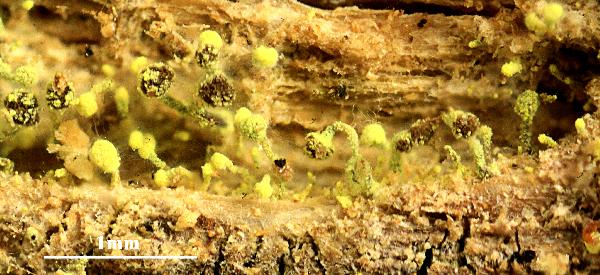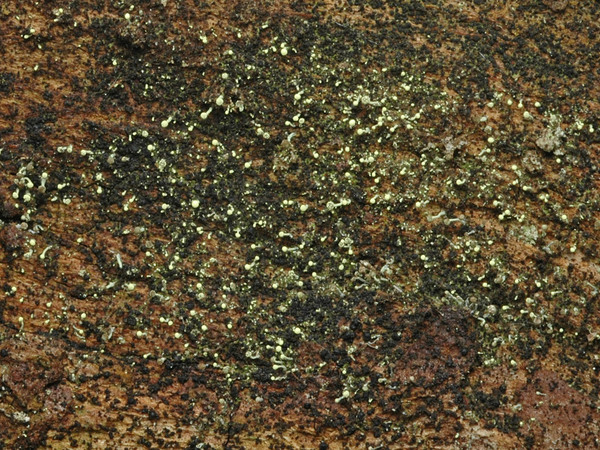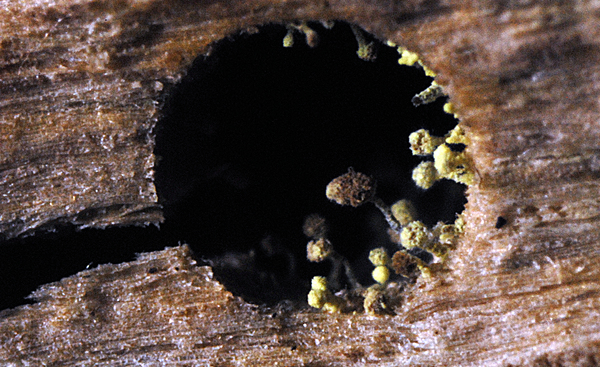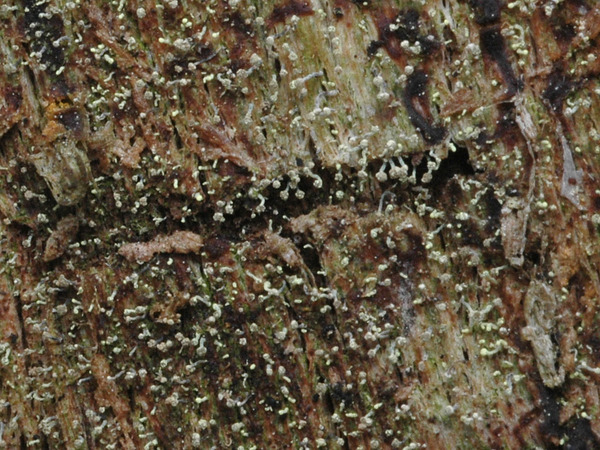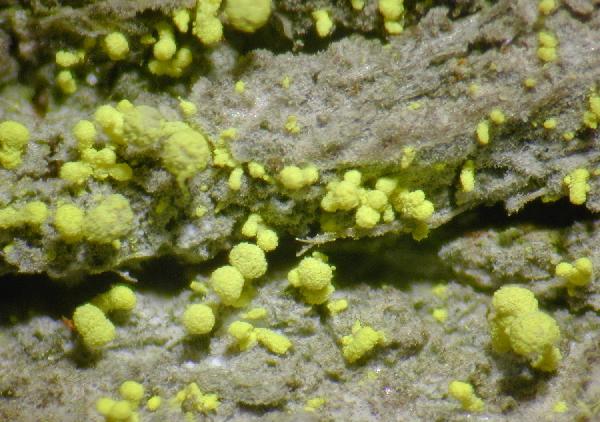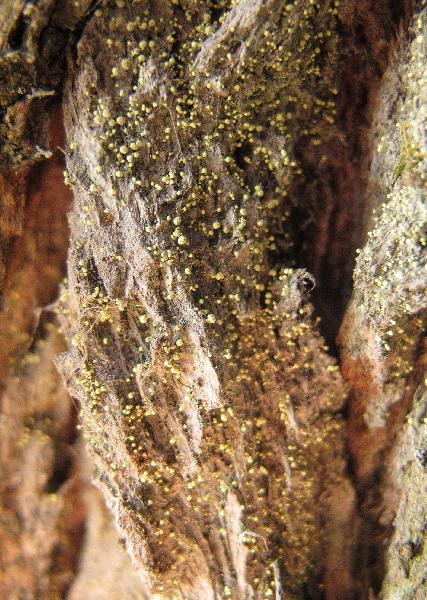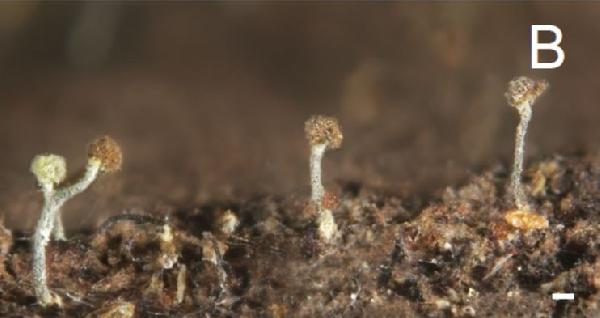Coniocybe brachypoda Ach.
K. Vetensk.-Akad. Nya Handl., 4: 287, 1816.
Synonyms: Chaenotheca brachypoda (Ach.) Tibell; Chaenotheca sulphurea (Retz.) Middelb. & Mattsson; Coniocybe furfuracea var. sulphurella (Fr.) Schaer.; Coniocybe griseola Ach.; Coniocybe sulphurea (Retz.) Nyl.; Coniocybe sulphurella (Fr.) Nyl.
Distribution: N - Frl (CLU 4209), Ven (Ravera & al. 2021), TAA (Puntillo & Puntillo 2009), Piem (Puntillo & Puntillo 2009), VA (Puntillo & Puntillo 2018). C - Tosc (Ravera & al. 2018b), Abr (Nascimbene & al. 2021). S - Camp (CLU 16353), Cal (Puntillo 1994, 1996, Puntillo & Puntillo 2009).
Description: Thallus crustose, endosubstratic and poorly visible. Apothecia stalked, pin-like, the stalk slender, 0.4-1.4 mm high, 0.04-0.08 mm thick, densely yellowish green-pruinose except sometimes in the black lowermost part, the inner part of periclinally arranged, medium brown hyphae, the outer part of dark brown, sclerotized hyphae. Capitulum spherical, 0.1-0.2 mm across, yellowish-green-pruinose, with a poorly developed excipulum of periclinally arranged hyphae, continuous with the stalk tissue and often reduced to a small basal collar. Mazaedium well-developed, dark to medium brown, but usually greenish-pruinose at least in young stages; hypothecium dark brown, with a convex upper surface. Asci cylindrical or irregular, formed in chains, dissolving early. Ascospores 1-celled, medium brown, globose to cuboid, 3-4.5 µm wide, the wall with a very minute ornamentation of tiny ridges and conspicuous, larger irregular cracks. Photobiont chlorococcoid, with rectangular cells (Stichococcus). Spot tests: thallus K-, C-, KC-, P-. Chemistry: thallus and pruina of the apothecia with pulvinic and vulpinic acids.Note: on decorticated stumps of deciduous and coniferous trees, more rarely on bark and siliceous rocks in old humid forests, on faces slightly protected from rain. Reported from both the Alps and the Apennines, but rare. It is included in the Italian red list of epiphytic lichens as “Endangered” (Nascimbene & al. 2013c).
Growth form: Crustose
Substrata: bark and lignum
Photobiont: green algae other than Trentepohlia
Reproductive strategy: mainly sexual
In underhangs rarely wetted by rain
Commonnes-rarity: (info)
Alpine belt: absent
Subalpine belt: absent
Oromediterranean belt: absent
Montane belt: very rare
Submediterranean belt: extremely rare
Padanian area: absent
Humid submediterranean belt: extremely rare
Humid mediterranean belt: absent
Dry mediterranean belt: absent
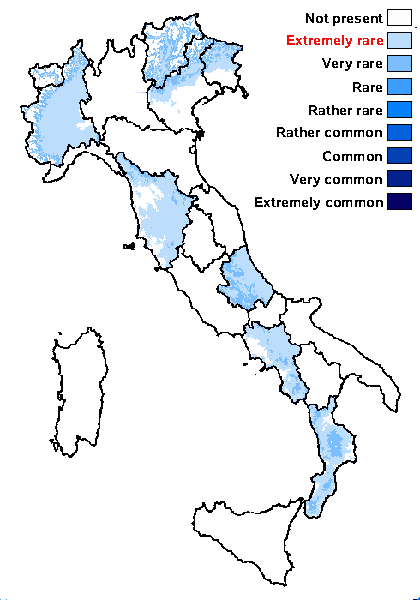
Predictive model
Herbarium samples
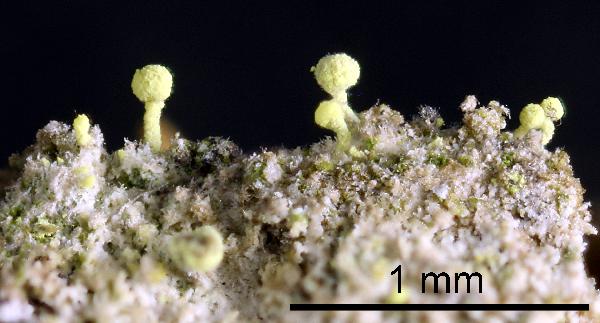

Felix Schumm - CC BY-SA 4.0
[12683], GERMANY: Rheinland-Pfalz, Moselgebiet, nördlich von
Treis-Karden im Pommerbachtal, ca. 50°11.295' N, 7°17.180' E, 190 m,
an Fraxinus. Leg. F. Schumm, (Moselexkursion mit Ch. Prinzen)
01.10.2006, det. L. Sparrius .
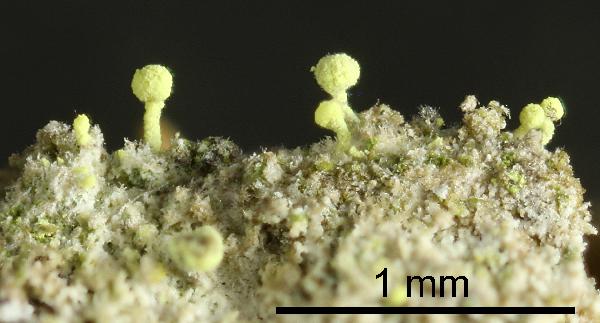

Felix Schumm - CC BY-SA 4.0
[12683], GERMANY: Rheinland-Pfalz, Moselgebiet, nördlich von
Treis-Karden im Pommerbachtal, ca. 50°11.295' N, 7°17.180' E, 190 m,
an Fraxinus. Leg. F. Schumm, (Moselexkursion mit Ch. Prinzen)
01.10.2006, det. L. Sparrius .
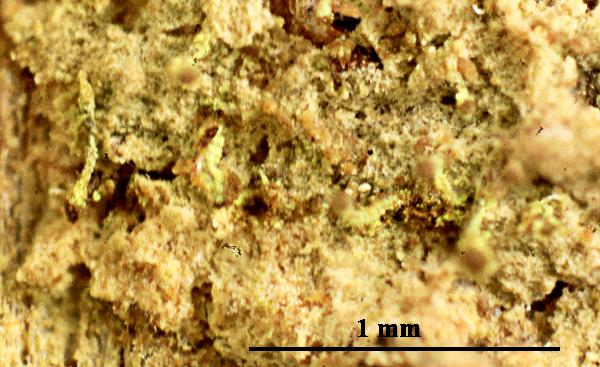

Felix Schumm - CC BY-SA 4.0
[VZ1254], Suecia. Wärmland: Östra Fågelvik, septentrionem versus a
Flatvik, 70m. Ad lignum siccum Betulae. Leg. S. W. Sundell (no.
9529), 16. 03.1974. EX A. V ZDA: LICHENES SELECTI EXSICCATI NR.
1254 - distributed as Coniocybe sulphurea (Retz.) Nyl.
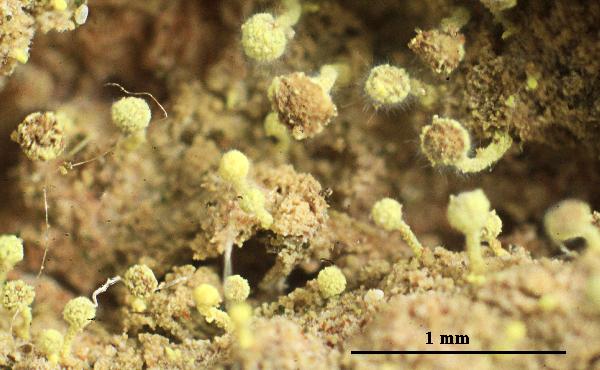

Felix Schumm - CC BY-SA 4.0
[VZ2473], Magna Britannia, Anglia. Suffolk: Capel St. Mary, 35 m. Adcorticem Sambuci nigrae. Leg. P. M. Earland-Benett, 13.02.1990, det.B. J. Coppins. EX A. VEZDA: LICHENES SELECTI EXSICCATI NR. 2473 -distributed as Coniocybe sulphurea (Retz.) Nyl..


Felix Schumm - CC BY-SA 4.0
[VZ2473], Magna Britannia, Anglia. Suffolk: Capel St. Mary, 35 m. Adcorticem Sambuci nigrae. Leg. P. M. Earland-Benett, 13.02.1990, det.B. J. Coppins. EX A. VEZDA: LICHENES SELECTI EXSICCATI NR. 2473 -distributed as Coniocybe sulphurea (Retz.) Nyl..
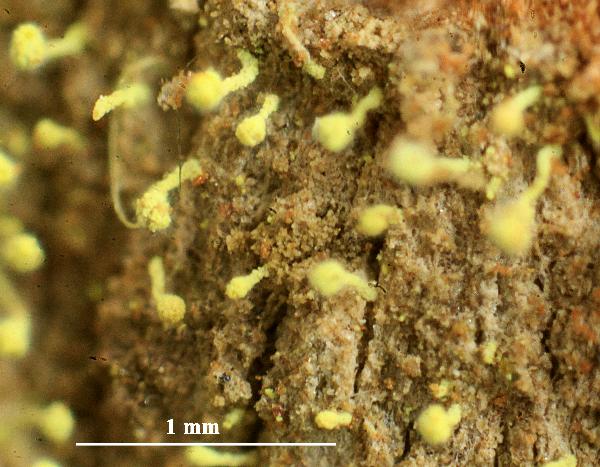

Felix Schumm - CC BY-SA 4.0
[VZR221], Moravia. Distr. Moravský Krumlov, in valle fluvii Rokytnásub collem Tábor, 280 m. Ad basim trunci arboris (Acer campestre).Leg. G. Bruna, Z. Palice & A. Vezda, 20.05.1996. EX A. VEZDA:LICHENES RARIORES EXSICCATI NR. 221.
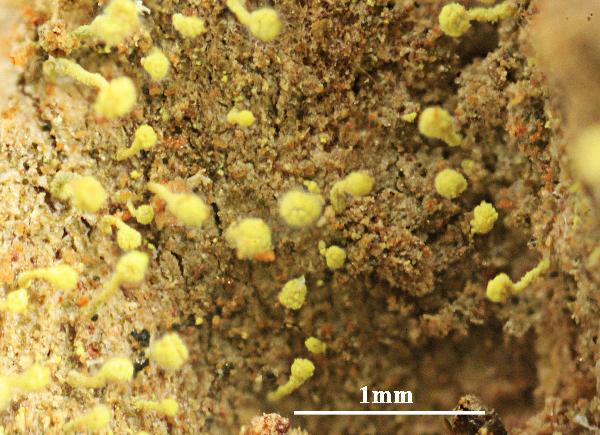

Felix Schumm - CC BY-SA 4.0
[[VZR221], Moravia. Distr. Moravský Krumlov, in valle fluvii Rokytnásub collem Tábor, 280 m. Ad basim trunci arboris (Acer campestre).Leg. G. Bruna, Z. Palice & A. Vezda, 20.05.1996. EX A. VEZDA:LICHENES RARIORES EXSICCATI NR. 221.], Bohemia merid., montes Šumava (Gabreta), distr. Volary, 3 km ad meridiem versus a
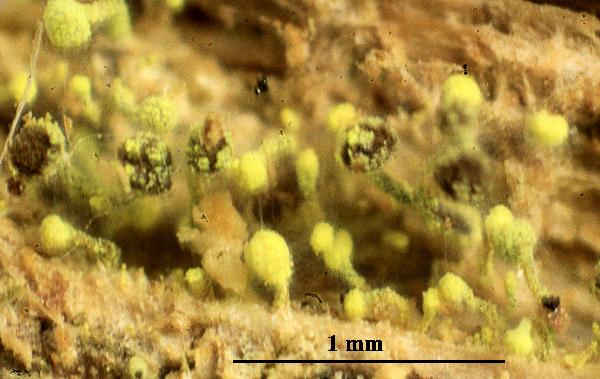

Felix Schumm - CC BY-SA 4.0
[VZR372], Bohemia merid., montes Šumava (Gabreta), distr. Volary, 3
km ad meridiem versus a " erny K íž", ad latera montis "Jeleni vrch",
850 m. Ad lignum trunci Fagi vetustae. Leg. Z. Palice, S. Bayerova &.
A. V zda. EX A. V ZDA: LICHENES RARIORES EXSICCATI NR. 372.
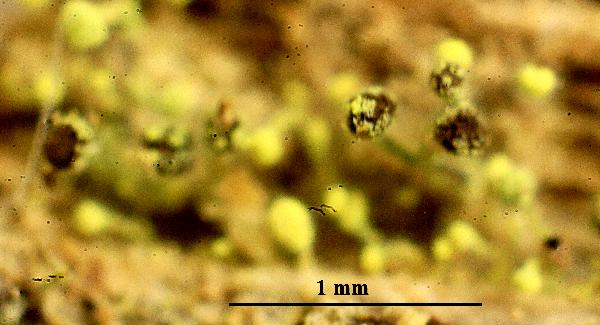

Felix Schumm - CC BY-SA 4.0
[VZR372], Bohemia merid., montes Šumava (Gabreta), distr. Volary, 3 km ad meridiem versus a " erny K íž", ad latera montis "Jeleni vrch", 850 m. Ad lignum trunci Fagi vetustae. Leg. Z. Palice, S. Bayerova &. A. Vezda. EX A. VEZDA: LICHENES RARIORES EXSICCATI NR. 372.
Growth form: Crustose
Substrata: bark and lignum
Photobiont: green algae other than Trentepohlia
Reproductive strategy: mainly sexual
In underhangs rarely wetted by rain
Commonnes-rarity: (info)
Alpine belt: absent
Subalpine belt: absent
Oromediterranean belt: absent
Montane belt: very rare
Submediterranean belt: extremely rare
Padanian area: absent
Humid submediterranean belt: extremely rare
Humid mediterranean belt: absent
Dry mediterranean belt: absent

Predictive model
| Herbarium samples |


Felix Schumm - CC BY-SA 4.0
[12683], GERMANY: Rheinland-Pfalz, Moselgebiet, nördlich von Treis-Karden im Pommerbachtal, ca. 50°11.295' N, 7°17.180' E, 190 m, an Fraxinus. Leg. F. Schumm, (Moselexkursion mit Ch. Prinzen) 01.10.2006, det. L. Sparrius .


Felix Schumm - CC BY-SA 4.0
[12683], GERMANY: Rheinland-Pfalz, Moselgebiet, nördlich von Treis-Karden im Pommerbachtal, ca. 50°11.295' N, 7°17.180' E, 190 m, an Fraxinus. Leg. F. Schumm, (Moselexkursion mit Ch. Prinzen) 01.10.2006, det. L. Sparrius .


Felix Schumm - CC BY-SA 4.0
[VZ1254], Suecia. Wärmland: Östra Fågelvik, septentrionem versus a Flatvik, 70m. Ad lignum siccum Betulae. Leg. S. W. Sundell (no. 9529), 16. 03.1974. EX A. V ZDA: LICHENES SELECTI EXSICCATI NR. 1254 - distributed as Coniocybe sulphurea (Retz.) Nyl.


Felix Schumm - CC BY-SA 4.0
[VZ2473], Magna Britannia, Anglia. Suffolk: Capel St. Mary, 35 m. Adcorticem Sambuci nigrae. Leg. P. M. Earland-Benett, 13.02.1990, det.B. J. Coppins. EX A. VEZDA: LICHENES SELECTI EXSICCATI NR. 2473 -distributed as Coniocybe sulphurea (Retz.) Nyl..


Felix Schumm - CC BY-SA 4.0
[VZ2473], Magna Britannia, Anglia. Suffolk: Capel St. Mary, 35 m. Adcorticem Sambuci nigrae. Leg. P. M. Earland-Benett, 13.02.1990, det.B. J. Coppins. EX A. VEZDA: LICHENES SELECTI EXSICCATI NR. 2473 -distributed as Coniocybe sulphurea (Retz.) Nyl..


Felix Schumm - CC BY-SA 4.0
[VZR221], Moravia. Distr. Moravský Krumlov, in valle fluvii Rokytnásub collem Tábor, 280 m. Ad basim trunci arboris (Acer campestre).Leg. G. Bruna, Z. Palice & A. Vezda, 20.05.1996. EX A. VEZDA:LICHENES RARIORES EXSICCATI NR. 221.


Felix Schumm - CC BY-SA 4.0
[[VZR221], Moravia. Distr. Moravský Krumlov, in valle fluvii Rokytnásub collem Tábor, 280 m. Ad basim trunci arboris (Acer campestre).Leg. G. Bruna, Z. Palice & A. Vezda, 20.05.1996. EX A. VEZDA:LICHENES RARIORES EXSICCATI NR. 221.], Bohemia merid., montes Šumava (Gabreta), distr. Volary, 3 km ad meridiem versus a


Felix Schumm - CC BY-SA 4.0
[VZR372], Bohemia merid., montes Šumava (Gabreta), distr. Volary, 3 km ad meridiem versus a " erny K íž", ad latera montis "Jeleni vrch", 850 m. Ad lignum trunci Fagi vetustae. Leg. Z. Palice, S. Bayerova &. A. V zda. EX A. V ZDA: LICHENES RARIORES EXSICCATI NR. 372.


 DOLICHENS
DOLICHENS
